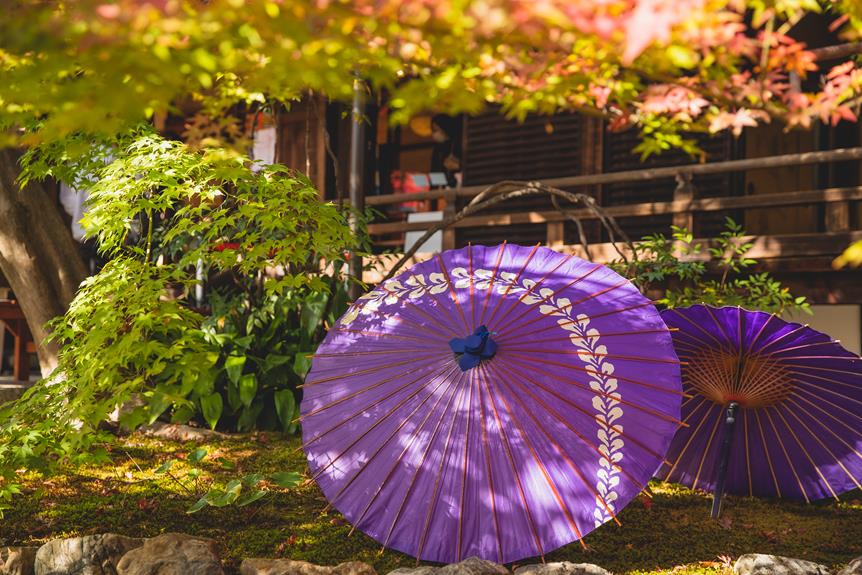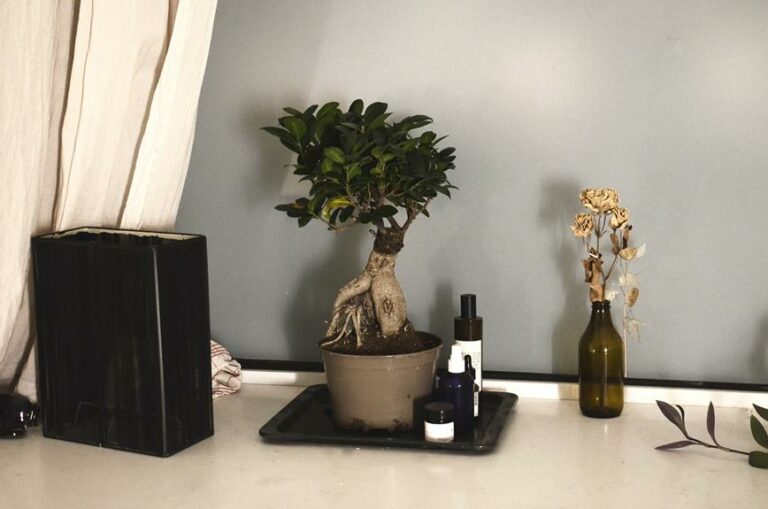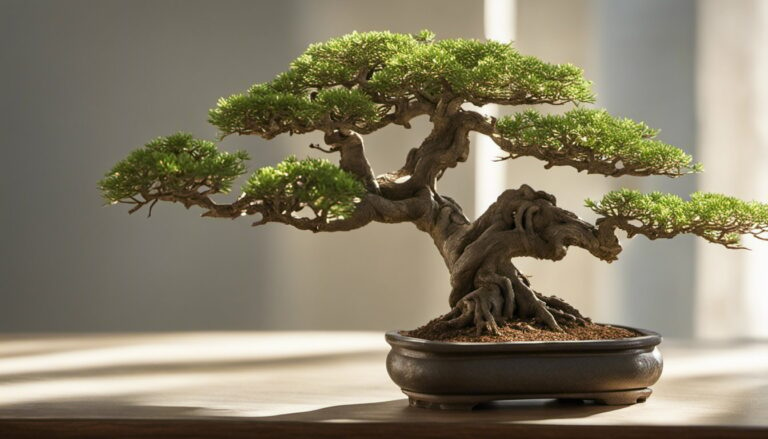Wiring and Styling Japanese Maple Bonsai
Personally, I believe that working with Japanese Maple Bonsai is a journey into the heart of artistry and nature’s elegance. In my view, the delicate craft of wiring and styling these miniature masterpieces allows us to sculpt living poetry.
As I see it, every bend and twist of a branch is a stroke on the canvas of bonsai creation. I strongly believe that this intricate process not only shapes the trees but also deepens our connection with them. In this article,
I’ll share my experience and insights on the enchanting world of wiring and styling Japanese Maple Bonsai, guiding you to create bonsai that embody the soul of your passion and dedication.
Robins Thoughts: Wiring and Styling Japanese Maple Bonsai
- Select appropriate wire for maple bonsai (consider thickness and strength)
- Wrap wire tightly around branch to ensure it stays in place
- Proper tools and wiring techniques create a beautifully styled bonsai
- Wiring helps shape the branches of the bonsai
Choosing the Right Wiring Tools
To achieve the best results when wiring and styling your Japanese maple bonsai, make sure you’ve the right tools for the job.
Wiring techniques are crucial in bonsai cultivation as they allow you to shape and train the tree’s branches.
The first step is to select the appropriate wire for your maple bonsai. Aluminum wire is commonly used for its flexibility and ease of manipulation. When choosing the wire, consider the thickness and strength needed to support the branches without causing damage. Thinner branches require thinner wire, while thicker branches need a stronger gauge.
It’s important to wrap the wire tightly around the branch, ensuring it stays in place. Remember to check the wire periodically to prevent any wire cutting into the tree’s bark.
With the right tools and proper wiring techniques, you’ll be able to create a beautifully styled Japanese maple bonsai.
Understanding the Growth Patterns of Japanese Maple
Understanding the growth patterns of Japanese Maple is crucial for shaping and pruning the tree to achieve optimal growth. By observing the natural direction of its growth, you can guide the branches and foliage to create a desired aesthetic appeal.
Knowing how the tree tends to grow will allow you to make informed decisions when it comes to training and maintaining your Japanese Maple bonsai.
Growth Direction Influences Shaping
You can shape the bonsai by influencing the growth direction of the Japanese maple. The growth direction plays a crucial role in achieving the desired shape and style of the bonsai tree. By using various shaping techniques, you can guide the growth of the branches and trunk to create a harmonious and balanced form.
One common technique is wiring, where you carefully wrap copper or aluminum wire around the branches to gently bend and position them in the desired direction. This allows you to create elegant curves and angles in the bonsai’s structure.
Another technique is pruning, which involves selectively removing branches to encourage new growth in specific areas. By understanding the growth patterns and employing these shaping techniques, you can create a stunning Japanese maple bonsai that showcases the beauty of nature in miniature form.
Pruning for Optimal Growth
By selectively removing branches, you can promote optimal growth in your tree. Pruning is an essential technique in bonsai cultivation as it helps shape the tree and maintain its health. Timing of pruning is crucial to ensure the tree’s growth and development.
Here are three important factors to consider when it comes to pruning techniques and timing:
- Season: Pruning should generally be done during the dormant season, which is usually in late winter or early spring. This allows the tree to recover quickly and minimizes stress on the plant.
- Branch selection: Carefully choose which branches to prune to maintain the overall shape and balance of the tree. Remove any dead, damaged, or crossing branches to improve air circulation and prevent disease.
- Growth pattern: Study the growth pattern of your tree and prune accordingly. Encourage outward growth by pruning back to buds facing in the desired direction. This will help create a more balanced and aesthetically pleasing tree.
Step-by-Step Guide to Wiring Techniques
Now that you have a good understanding of the growth patterns of Japanese Maple, it’s time to learn the step-by-step guide to wiring techniques.
Wiring is an essential skill in bonsai cultivation as it allows you to shape and style your tree according to your desired aesthetic.
In this section, we’ll explore basic wiring techniques, how to style with wire, and most importantly, common wiring mistakes to avoid.
Basic Wiring Techniques
To achieve the desired shape, gently bend the branches of the Japanese maple bonsai using basic wiring techniques. This process involves carefully wrapping wires around the branches and trunk to guide their growth and create the desired structure.
Here are three key points to consider when applying wire to your bonsai:
- Choose the right wire gauge: The thickness of the wire should match the branch’s size and flexibility. If the wire is too thin, it won’t hold the branch in place. If it’s too thick, it may damage the branch or leave visible marks.
- Wrap the wire in a spiral pattern: Start at the base of the branch and wrap the wire in a spiral motion, moving upwards. Make sure the wire is snug but not too tight, allowing room for the branch to grow.
- Use advanced wiring techniques sparingly: While basic wiring techniques are sufficient for most bonsai, advanced techniques like double-wiring or guy wires can be used for more complex shapes or thick branches.
Styling With Wire
When creating the desired structure for your tree, make sure to choose the appropriate wire gauge for each branch, wrap it in a spiral pattern, and use advanced techniques sparingly.
Advanced wiring techniques can be used to achieve more intricate and complex designs in your Japanese maple bonsai. These techniques involve techniques such as thread grafting, approach grafting, and thread and approach grafting combined. However, it’s important to remember that these techniques should be used sparingly and with caution, as they can be more invasive and may require more skill and experience to execute properly.
Additionally, alternative styling methods can be explored, such as using guy wires or weights to gently guide the branches into the desired position over time. These methods can help create a more natural and organic appearance for your bonsai tree.
Common Wiring Mistakes
Avoid making the mistake of using wire that’s too thick for the branches, as this can cause damage and inhibit proper growth. When wiring your Japanese maple bonsai, it’s important to avoid wire damage and ensure proper wire placement. Here are some key points to keep in mind:
- Use wire that’s appropriate for the size and flexibility of the branches. Thin, flexible wire is ideal for young and delicate branches, while thicker wire can be used for thicker and stronger branches.
- Avoid placing wire too tightly on the branches, as this can cause indentation and restrict the flow of sap. Leave some space between the wire and the branch to allow for growth.
- Be mindful of the direction in which you apply the wire. It should follow the natural movement and shape of the branch, helping to create the desired bonsai style.
Creating Artistic Curves and Movement in Branches
You can enhance the artistic appeal of your Japanese maple bonsai by creating graceful curves and movement in its branches. This can be achieved through various shaping techniques.
One popular method is using wire to guide the branches into desired positions. Start by selecting a branch that you want to shape. Gently wrap the wire around the branch, starting at the base and working your way up. Be careful not to wrap the wire too tightly, as it can cause damage.
Once the wire is in place, you can carefully bend and position the branch, creating the desired curves and movement. Remember to regularly check the wire to ensure it doesn’t cut into the branch as it grows.
With practice and patience, you can create beautiful artistic movement in your Japanese maple bonsai.
Styling Methods for Enhancing the Beauty of Japanese Maple Bonsai
To enhance the beauty of your miniature tree, consider using different methods to style and shape its branches. By utilizing various pruning techniques and seasonal care, you can achieve a stunning Japanese maple bonsai that captivates the eyes of all who see it.
Here are three styling methods to help you enhance the beauty of your Japanese maple bonsai:
- Pruning: Regularly prune your bonsai to remove any dead or unwanted branches. This won’t only improve the overall appearance of your tree but also promote healthy growth.
- Wiring: Use wiring techniques to shape the branches of your bonsai. By carefully wrapping wire around the branches and gently bending them, you can create elegant curves and movement that mimic the natural growth patterns of a full-sized maple tree.
- Seasonal Care: Provide appropriate care for your bonsai throughout the different seasons. This includes adjusting watering and fertilization schedules, as well as protecting your tree from extreme temperatures.
Refining Branch Placement and Balance
Achieve a harmonious and balanced appearance by refining the placement of branches on your miniature tree. When it comes to styling your Japanese maple bonsai, it’s crucial to consider the thickness of each branch and the negative space it creates in the overall design. By carefully pruning and wiring the branches, you can achieve a more refined and elegant look.
To better understand the concept of refining branch thickness and creating negative space, refer to the table below:
| Branch Thickness | Negative Space |
|---|---|
| Thick | Limited |
| Medium | Moderate |
| Thin | Abundant |
Maintenance and Care Tips for a Healthy and Beautiful Bonsai
Maintaining a healthy and beautiful bonsai requires regular watering, proper pruning, and regular feeding with fertilizer. Here are some tips to help you take care of your bonsai:
- **Watering:** Bonsai trees are sensitive to both overwatering and underwatering. You should water your bonsai regularly, ensuring that the soil is moist but not waterlogged. The frequency of watering depends on factors such as the size of the pot, the type of tree, and the climate.
- **Choosing Suitable Soil:** Bonsai trees require well-draining soil to prevent root rot. Opt for a well-balanced bonsai soil mix that consists of components like akadama, pumice, and lava rock. This type of soil promotes good root growth and prevents waterlogging.
- **Preventing Pests and Diseases:** Regularly inspect your bonsai for signs of pests or diseases. Common pests include aphids, spider mites, and scale insects. Treat infestations promptly using organic insecticides or by manually removing the pests. Additionally, maintain good hygiene by removing dead leaves and debris from the soil surface to prevent fungal diseases.
My Personal Experience
In my personal experience, I strongly believe that wiring and styling Japanese Maple Bonsai is akin to conducting a symphony with nature’s finest instruments. As I see it, every twist and turn of a branch is an intimate conversation with the tree. From my perspective, I’ve had a hunch that no two bonsai are the same, and it’s our responsibility to unlock their individual beauty.
Over the years, I’ve seen the trees respond to my careful guidance, creating art that mirrors the spirit of the maple. I can’t help but think that this journey has allowed me to appreciate the subtle rhythms of growth and harmony in the bonsai world. It’s been my long-held conviction that through wiring and styling, we become not just caretakers but artists, crafting the beauty of nature.
Conclusion
I strongly believe that the art of wiring and styling Japanese Maple Bonsai is a journey of dedication and artistry. It’s been our experience that each curve and bend in a branch carries the essence of a timeless partnership between the gardener and the tree. From our informed perspective, this practice not only transforms the trees but also deepens our understanding of their natural grace.
I have a feeling that as you embark on your own bonsai journey, you’ll discover that wiring and styling these magnificent trees is not just a horticultural task; it’s a profound connection with nature itself. It’s our firm conviction that in this art form, we find a reflection of our own patience, artistry, and the subtle beauty of growth and transformation.




